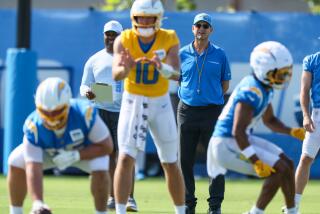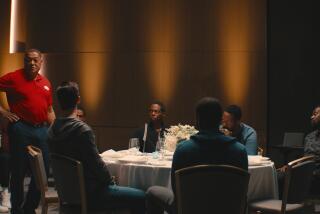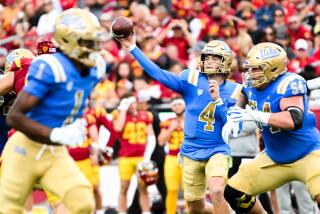Makeshift Pros Call It a Career After One Day
- Share via
PHILADELPHIA — This will be the last you hear of Rich Comizio and A.J. Sebastianelli, two guys who walked briskly away from their abbreviated dream-come-true earlier this week.
By now, Comizio is back on Wall Street, doing his best to learn the business of commodities trading. Sebastianelli has returned to the University of Pennsylvania, where he will complete a degree while helping coach the freshman football team.
For a single day, they were professional football players. At least, that’s what they thought when they arrived at Veterans Stadium for their very first practice.
Eagle wings decorated their helmets. Jerseys that once belonged to striking National Football League players were now theirs. Comizio wore No. 28. Sebastianelli was issued No. 99, previously owned by first-round draft choice Jerome Brown.
“It was great,” Sebastianelli said. “I was dressed in an Eagle uniform. I was on the field. I was walking around saying, ‘Yeah, I’m an Eagle.’ ”
But he wasn’t, just as the fellas visiting Rams Park these days aren’t really the Rams. And the hired hands attired in Chicago Bear uniforms aren’t actually Midway Monsters. And so on. And so forth.
They are understudies, nothing more. They have been hired to do a job, the least of which is to play football.
Under the pretense of opportunity, of a chance of a lifetime, the Comizios and Sebastianellis of the world made their way to assorted NFL stadiums this week. They were told they were there to play football when, in reality, they were there to prove a point.
Comizio, who is 5-feet 9-inches tall and weighs 180 pounds, was a competent enough running back at Penn. Sebastianelli, 6-2 and 230, played defensive end. It was a nice team, full of good intentions, but hardly a frequent visitor to the top 20.
Then along came the player strike, and suddenly two Ivy Leaguers--ignored during the draft, never contacted as free agents--found themselves in Eagle uniforms.
Comizio was granted a one-week leave of absence from his job in New York. Sebastianelli informed the coaches at Penn that they would have to make do without him.
“I was running around my apartment like a nut, calling people, saying, ‘I’m an Eagle, I’m an Eagle,’ Sebastianelli said. “You have to understand, I was so excited.”
Reality arrived soon thereafter.
First was this matter of practice. Unlike your average midweek NFL workout, Eagle replacement players were asked to scrimmage not long after they walked on the field. “For me, that’s insane,” Comizio said. “I’ve never heard of guys going live on Day 1.”
Next came guilt.
“I had an Eagles helmet on and that’s what started to bother me,” Sebastianelli said. “I had another guy’s number. If I were a pro and I was sitting down on a Sunday afternoon with the kids, I wouldn’t want them to say, ‘Daddy, why is he wearing your jersey?’ ”
Comizio and Sebastianelli had fun, mind you. How often do you get paid to pretend you’re an NFL player?
Sebastianelli pulled up the sleeve of his T-shirt and revealed a blossoming bruise, several abrasions and rug burns from the stadium turf. Mementos of sorts. “Yeah, we got to scrap it up,” he said.
But as the workout wore on, Comizio said he felt less a player and more an intruder. It was like sneaking into your dad’s closet and wearing his clothes; nothing fits.
Every so often would come rumors of an impending strike settlement. Gene Upshaw, the union executive director, and Jack Donlan, the owner’s chief representative, were in a midtown hotel, supposedly close to finding a way to return the real NFL players to their teams.
Assistant coaches would stop on their way to practice and ask reporters, “Any news, yet?”
Said Comizio: “I think the coaches obviously want the strike over as much as the players do. It took me a day to realize. I felt exploited. The Eagles’ staff could care less if I was there or not. They’d just replace me with somebody else tomorrow. They were just waiting for the call for this (strike) to be over, so they could send us all home.”
“There was just something missing,” Sebastianelli said.
NFL owners contend that America wouldn’t know the difference between a Comizio and a Dickerson, that no one really would mind watching a Sebastianelli instead of a Brown. “I think the games will be very exciting, and they’ll be very competitive,” Donlan said Friday as the negotiations recessed with a thud.
Exciting? Possibly. Competitive? Maybe. Full of integrity? Professional wrestling has more honor.
After their first and last practice as make-believe Eagles, Comizio and Sebastianelli returned to a nearby hotel. They had to make their way past a picket line. They had to receive security clearance as they entered the hotel lobby. This was the NFL?
A pizza was ordered. When the delivery man arrived, so did two striking Eagle players.
“I wasn’t physically afraid, but I didn’t know what they wanted,” Sebastianelli said. “I wasn’t expecting them. They came in and said, ‘Son, do you know what you’re doing?’
“I was kind of cocky at first,” he said. “I was telling them, ‘Hey, playing pro football has always been my dream. You guys play the game, you know what it’s about. I want my chance. I know what I’m doing. Listen to me. . . . I’m chasing a dream.’ ”
Later, Comizio spoke with a longtime friend, John Spagnola, who serves as the Eagles’ player representative. By the conversation’s end, Comizio and soon, Sebastianelli, had decided to retire.
“It’s not a pro career,” Sebastianelli said. “It’s a pseudo pro career as far as I’m concerned.”
So they left. The next day, several other replacement players quit. Turns out fake football isn’t what it was cracked up to be.
Next week, it appears, we will discover just how silly this is. If Comizio and Sebastianelli are right, then management and Strike Ball ’87 deserve plenty more omelet ingredients directed their way.
More to Read
Go beyond the scoreboard
Get the latest on L.A.'s teams in the daily Sports Report newsletter.
You may occasionally receive promotional content from the Los Angeles Times.










